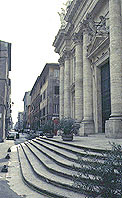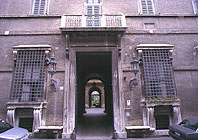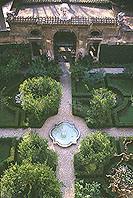Via Giulia
Named for Pope Julius II della Rovere (1503-13) who imposed an urbanization plan on Medieval Rome, transforming it into a Baroque city with broad straight avenues for the glorification of the Catholic Church.
Via Giulia was for pilgrims to reach St. Peter's square without having to weave their way through back alleys. It quickly became, and remains today, Rome's smartest address.
St. Giovanni dei Fiorentini

Despite the uninspiring 18C facade, this is a Baroque church in which several accomplished 17C architects (Sansovino, Antonio da Sangallo, Carlo Maderno) participated.
Pope Leo X Medici built it for his Florentine compatriots who peopled this quarter, but unfortunately he did not accept either of the plans which were submitted by the great geniuses of the high Renaissance, Michelangelo and Raphael.
More recently there were weekly masses for animals to which you could bring your household pets for a blessing.
Raphael's House
(Casa di Raffaello): So-called because he owned the land, like many other artists who snapped up nearby plots on the new street. But he died too soon and the house was built after his death.
Palazzo Sacchetti
 Antonio Sangallo, architect of the Palazzo Farnese, built it (1542) for himself; after his death it passed first into the hands of Cardinal Giovanni Ricci who had Nanni di Baccio Bigio enlarge it, then came the Sacchetti family, who still live in it today.
Antonio Sangallo, architect of the Palazzo Farnese, built it (1542) for himself; after his death it passed first into the hands of Cardinal Giovanni Ricci who had Nanni di Baccio Bigio enlarge it, then came the Sacchetti family, who still live in it today.
This vast Renaissance pile has a courtyard in the center and a garden in back that originally sloped down to the river's edge.

Since the late 19C construction of the Lungotevere embankment road, the Sacchettis do not get flooded regularly like their predecessors, but the formal Italian garden is much abbreviated and its giant antique sculpted heads look out of proportion.
Don't miss the ruined fountain on the corner of Via Giulia and Vicolo del Cefalo where that boy on a dolphin used to make water in the most natural way.
St. Biagio
Facade 1730, architect G.A. Perfetti. The Armenian community church is named after the Armenian Bishop St. Blaise (martyred in 316) protector of the throat.
On his feast day, 3 February, after an Armenian choral mass, each participant is given a small bread loaf, "pagnotta", giving this church the name "San Biagio della Pagnotta."
Sofas of Via Giulia
(I sofà di Via Giulia). These are the huge unfinished travertine blocks that extrude from the buildings on the right side of the street, the remains of an unfinished law court Bramante designed for Pope Julius II.
Oratorio di St. Lucia del Gonfalone
Down the little Vicolo della Scimmia (Monkey Lane) is the entrance to this guildhall of the Medieval confraternity of flag carriers.
Blood sports in the Colosseum were superseded in the Middle Ages by extravagant religious processions with floats and flags organized by the many confraternities (see also St. Giovanni Battista).
Concerts are still held in the main oratory hall, which has a cycle of 12 beautiful frescoes painted in 1573 by Federigo Zuccari and others of the Passion of Christ.
New Prisons
(Carceri Nuove). Pope Innocent X had this built (1655, architect A. del Grande) as a model prison, and it served as such until the end of the 19C when it was replaced by the huge and ugly Regina Coeli Jail just across the river.
The sign on the facade reads "for a safer and more humane imprisonment of the guilty." (On nearby Via del Gonfalone another prison, built 200 years later, was exclusively for children, but is also now abandoned).
St. Filippo Neri
(Chiesa di San Filippo Neri). Only the facade (1728, architect F. Raguzzini) remains.
Mussolini wanted to destroy all the buildings in this area so that a wide road could lead from Ponte Mazzini to the Chiesa Nuova on nearby Corso Vittorio Emanuele. But a public uproar actually forced the dictator to abandon his plan before he could tear down this disemboweled church's facade.
Spirito Santo of the Neapolitans
(Chiesa dello Spirito Santo dei Napoletani) (1700, architect Carlo Fontana). The flamboyance of Neapolitan baroque at its worst.